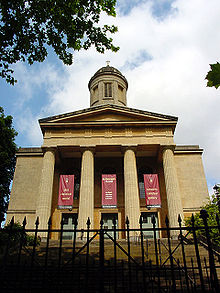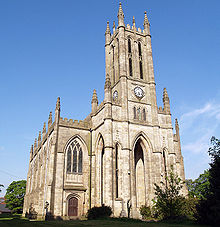- Commissioners' church
-
A Commissioners' church is an Anglican church in the United Kingdom built with money voted by Parliament as a result of the Church Building Act of 1818 and 1824. They have been given a number of titles, including Commissioners' churches, Waterloo churches and Million Act churches (or "Million churches"). The 1818 Act supplied a grant of money and established the Church Building Commission to direct its use, and in 1824 made a further grant of money. In addition to paying for the building of churches, the Commission had powers to divide and subdivide parishes, and to provide endowments. The Commission continued to function as a separate body until the end of 1856, when it was absorbed into the Ecclesiastical Commission. In some cases the Commissioners provided the full cost of the new church; in other cases they provided a grant and the balance was raised locally.
Contents
Title
The first First Parliamentary Grant for churches amounted to £1 million (£49,820,000 as of 2011)[1]. The Second Parliamentary Grant of 1824 amounted to an additional £500,000, so the term "million" cannot apply to all the churches aided by the Commission. The Commission was founded on a wave of national triumph following the defeat of Napoleon at the Battle of Waterloo in 1815; hence the suggestion of the word "Waterloo" in the title. But even if this were a factor in founding the Commission, again it could only apply to the earlier phases of building. The term "Commissioners' church" covers the whole of the work of the Church Building Commission and it is the term normally used by architectural historians, including M. H. Port in 600 New Churches, and the authors of the Pevsner Architectural Guides.
Background
Towards the end of the 18th century the Church of England was facing a number of problems and challenges. Due to factors including the Industrial Revolution, the population of Britain had grown, and it had redistributed, tending to concentrate in urban centres, some older and expanded, others newly created. Meanwhile the organisation of the Church of England had not been modified to reflect this change, leading to a mismatch between the population and the pastoral services provided by the church.[2] For example, Stockport with a population of nearly 34,000 had church seating for only 2,500, Sheffield had 6,280 seats for 55,000 people, Manchester had 11,000 for nearly 80,000, and the St Marylebone district of London had only 8,700 places for 76,624 inhabitants.[3] In addition, there was a concern in society that, following the French Revolution of 1789–99, there might be a similar uprising in Britain. It was considered that "the influence of the Church and its religious and moral teaching was a bulwark against revolution".[4] Some argued that a major function of the church was to complement the work of the state; that "the church's main function was social control".[5] On top of this, the Church of England has its own internal problems, some of them even amounting to abuses, such as pluralism (vicars owning more than one benefice), absenteeism (vicars employing curates to run their parishes) and non-residence. There was a great disparity between the incomes of the parochial clergy. The educational level of the clergy and their training was often inadequate.[6][7] Challenges to the church came from main two sources, Dissent and secularism. Dissenters were those Christians who did not ascribe to the practices of the established church (the Church of England), and they included the older independent churches such as the Quakers, Baptists and Congregationalists, and the newer movement of Methodism. The rise of these movements was blamed partly on the lack of accommodation in the churches provided by the state church.[8]
During the early 1810s groups were formed to address these problems by both active parties in the Church of England, the Evangelicals and the High Churchmen.[9] Joshua Watson, a layman, was a prominent member of the High Church group; he has been described as "the greatest lay churchman of his day" and was to become "the cornerstone of the [Church Building] Commission", on which he served for 33 years.[10] Because of the legal structure of the Church of England, it was "almost indispensable to obtain an Act of Parliament before a church was rebult, or a new one built " and "to divide a parish an Act was essential".[11] There was growing pressure for Parliament to meet the problems. Following the defeat of Napoleon in 1815 there was also a movement to build churches "as a "national thank-offering".[12] In December 1815 Joshua Watson and the pamphleteer John Bowdler, wrote a "memorial" to the Prime Minister, Lord Liverpool, arguing the case for more churches.[13] There was initial reluctance from the politicians to the proposal, partly because of the financial deficit following the Napoleonic Wars.[14] In 1817 a committee was appointed to form a society for "promoting public worship by obtaining additional church-room for the middle and lower classes".[15] This was successful and at a public meeting on 6 February 1818 in the Freemasons' Hall, London chaired by Charles Manners-Sutton, the Archbishop of Canterbury, the Duke of Northumberland proposed a motion to form the Church Building Society, and this was accepted. This led to Parliament's agreement to provide the First Parliamentary Grant of £1 million for building new churches.[16] The Church Building Act 1818 was debated in Parliament and passed later that year.[17]
The Commission
The first Commission consisted of 34 members, both clergy and laity being represented.[18][19] In addition to providing grants of money, the Commission had powers to divide and subdivide parishes and to provide endowments.[20]
The Commission appointed George Jenner as its secretary, and then had to decide how to apportion its funds. It set its maximum sum for a grant at £20,000 (£25,050,000 as of 2011)[1] each, but this would have built only 50 churches. A degree of economy was necessary, but it was considered that the churches should be recognisable as those of the Church of England, with a tower and even a spire. Thomas Rickman was appointed to prepare plans in the diocese of Chester. Applicants for grants had to abide by rules drawn up by the Commission. The designs for the churches were to be decided by competition, but the churches had to be soundly built.[21] In some cases the Commission provided the whole cost of the building. On occasions this exceeded the cost of the building and also included the cost of the site and legal charges. Often the grant was less than the cost of the building, the difference being met by private donations and public subscription. In no case was the recommended ceiling of £20,000 exceeded. The highest grant was of £19,948 for St Martin's Church in Liverpool.[22]
By February 1821, 85 churches had been provided with seating for 144,190. But only £88,000 (£6,350,000 as of 2011)[1] of the original £1 million remained. Applications for 25 more churches had to be postponed and it was clear that more money would be needed from Parliament.[23] This led to the Church Building Act 1824 that provided the Second Parliamentary Grant of £500,000.[24] This money was distributed much more widely and, on the whole the grants were less generous. The First Parliamentary Grant was shared between less than 100 churches;[25] the Second Parliamentary Grant went to over 500 churches. Grants to churches covering the full cost of building were less frequent than from the First Parliamentary Grant. The highest grant was of £10,686 to All Saints Church, Skinner Street in the City of London, but this was exceptional. Most grants were between £100 and £1,000; on some occasions the grant was a mere £5.[26] The Church Building Commission continued to function until 1 January 1857, when it was absorbed into the Ecclesiastical Commission.[20]
See also
- List of Commissioners' churches in eastern England
- List of Commissioners' churches in the English Midlands
- List of Commissioners' churches in London
- List of Commissioners' churches in Northeast and Northwest England
- List of Commissioners' churches in southwest England
- List of Commissioners' churches in Wales
- List of Commissioners' churches in Yorkshire
- Victorian restoration
References
- Notes
- ^ a b c UK CPI inflation numbers based on data available from Lawrence H. Officer (2010) "What Were the UK Earnings and Prices Then?" MeasuringWorth.
- ^ Parsons 1988, p. 18.
- ^ Port 2006, p. 22.
- ^ Port 2006, p. 15.
- ^ Best, W. quoted in Port 2006, p. 16.
- ^ Parsons 1988, pp. 18–19.
- ^ Port 2006, pp. 16–17, 22–23.
- ^ Port 2006, pp. 17–18, 24.
- ^ Port 2006, pp. 18–19.
- ^ Port 2006, p. 19.
- ^ Port 2006, p. 23.
- ^ Port 2006, pp. 24–25.
- ^ Port 2006, p. 25.
- ^ Port 2006, p. 27.
- ^ Port 2006, p. 28.
- ^ Port 2006, p. 29.
- ^ Port 2006, pp. 37–43, 363.
- ^ The clergy included the Archbishop of Canterbury, Edward Venables Vernon, Archbishop of York, William Howley, then Bishop of London and later Archbishop of Canterbury, James Cornwallis, Bishop of Lichfield and Coventry, Brownlow North, Bishop of Winchester, George Pretyman Tomline, Bishop of Lincoln, George Henry Law, Bishop of Chester, John Ireland, Dean of Westminster, Richard Mant, rector of St Botolph-without-Bishopsgate, Francis John Hyde Wollaston, Canon of St Paul's Cathedral, Joseph Holden Pott, rector of St Martin-in-the-Fields, Thomas Dunham Whitaker, Vicar of Whalley and Blackburn, and Christopher Wordsworth, rector of Lambeth. The lay members included Joshua Watson, Nicholas Vansittart, Chancellor of the Exchequer, Lord Harrowby, Lord President of the Council, Sir John Nicholl, and William Scott (the last two were lawyers).
- ^ Port 2006, pp. 30–35.
- ^ a b Port 2006, p. 12.
- ^ Port 2006, pp. 45–51.
- ^ Port 2006, pp. 325–329.
- ^ Port 2006, p. 54.
- ^ Port 2006, pp. 227–229.
- ^ Port 2006, pp. 326–329.
- ^ Port 2006, pp. 331–347.
- Bibliography
- Parsons, Gerald (1988), "Reform, Revival and Realignment: The Experience of Victoria Anglicanism", in Parsons, Gerald, Religion in Victorian Britain, I: Traditions, Manchester: Manchester University Press, ISBN 0 7190 2511 7
- Port, M. H. (2006), 600 New Churches: the Church Building Commission 1818-1856 (2nd ed.), Reading: Spire Books, ISBN 978-1-904965-08-4
Categories:- Commissioners' churches
- 19th-century architecture
- Romanesque Revival architecture
- Gothic Revival architecture in England
Wikimedia Foundation. 2010.


